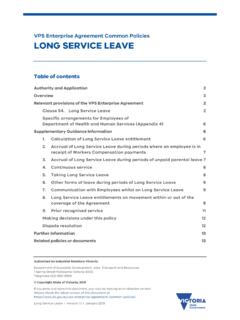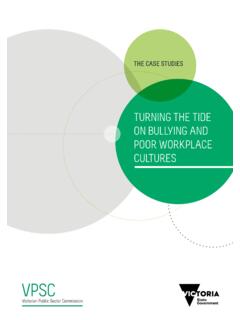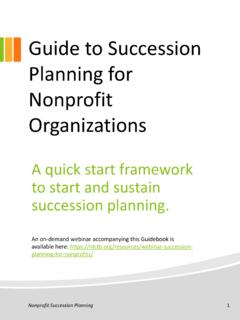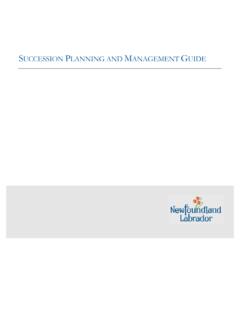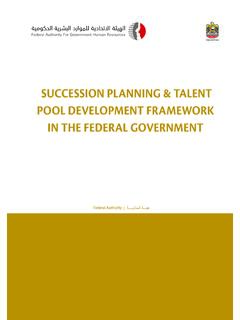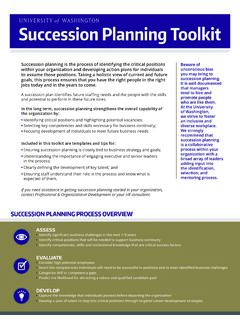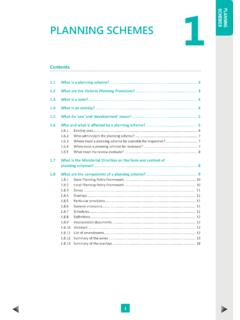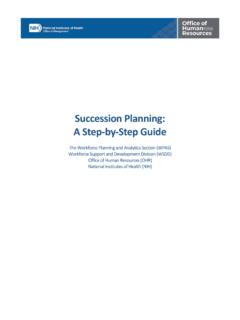Transcription of workforce planning toolkit - VPSC
1 1. workforce planning toolkit a guide for workforce planning in small to medium sized victorian public sector organisations workforce planning toolkit a guide for workforce planning in small to medium sized victorian public sector organisations The Victorian Government has vested the State Services Authority with functions designed to foster the development of an efficient, integrated and responsive public sector which is highly ethical, accountable and professional in the ways it delivers services to the Victorian community. The key functions of the Authority are to: Identify opportunities to improve the delivery and integration of government services and report on service delivery outcomes and standards;. Promote high standards of integrity and conduct in the public sector;. Strengthen the professionalism and adaptability of the public sector; and Promote high standards of governance, accountability and performance for public entities.
2 The Authority and public sector organisations have an important role to play in demonstrating and reinforcing the Victorian public sector values and employment principles outlined in the Public Administration Act 2004. The values establish the nature of our relationship with Government, the community and our work colleagues, and extend to everything we do. The principles reinforce the values. They relate to such things as merit in employment and fair and reasonable treatment of staff, and are integral to sustaining a highly effective and harmonious public sector workplace. When taken together, the values and principles suggest a mutual responsibility between public sector employers and employees. A responsibility to work together to: Create pride and commitment in public sector workplaces Excel in the delivery of world class public services Earn the community's trust in the public sector Support the government of the day in serving Victorians.
3 Contact us at the State Services Authority Email: Phone: (03) 9651 1321. Fax: (03) 9651 0747. Postal Address: 3 Treasury Place Melbourne 3002. Published 2006. Copyright State Government of Victoria State Services Authority 2006. contents 1 introduction 1. purpose of guide 1. what is workforce planning ? 2. why implement workforce planning ? 3. 2 how to implement workforce planning 4. the victorian public sector workforce planning model 4. the key elements of the model 5. the critical issue of scope 6. 3 workforce analysis 7. reviewing organisation direction and external environment 7. analysing internal and external labour forces 9. what does better practice look like? 11. quick check where is the organisation? 13. 4 forcast needs 16. understanding future work requirements 16. identifying future competencies 17. developing forecasting models 18. developing forecasting assumptions and scenario building 18. what does better practice look like?
4 19. quick check where is the organisation? 20. 5 analyse gaps 22. identifying and analysing gaps 22. prioritisation of work 23. identifying potential directions for action 23. what does better practice look like? 24. quick check where is the organisation? 25. 6 develop strategies 26. strategy formulation 26. establishing the case for change 27. establishing success criteria 28. what does better practice look like? 29. quick check where is the organisation? 30. 7 implement strategies 31. execution of strategies 31. developing a change management strategy 32. align workforce planning strategies with organisational values and culture 33. what does better practice look like? 34. quick check where is the organisation? 35. 8 monitor and evaluate 36. monitor 36. evaluate 37. what does better practice look like? 38. quick check where is the organisation? 39. 1 introduction purpose of guide This Guide was developed to provide a source of information on the common elements of workforce planning for small to medium-sized Victorian public sector organisations.
5 The Guide discusses workforce planning by suggesting: what key questions to ask? identifies the key questions to explore for each element of workforce planning . what better practice looks like? identifies the better practice elements of workforce planning that exist in organisations that have successfully implemented workforce planning . a checklist to help assess the level of workforce planning in the organisation . a self assessment checklist that enables a quick assessment of the level of workforce planning within an organisation. The checklist contains a list of questions and practice examples relating to each stage of workforce planning . It can be used to measure the current level of workforce planning , as well as indicating what other actions can be implemented to further embed workforce planning within an organisation. workforce planning toolkit a guide for workforce planning in small to medium sized victorian public sector organisations 1.
6 What is workforce planning ? At the simplest level, workforce planning is about Getting the right number of people with the right skills in the right jobs at the right time . A more detailed definition is determining and shaping the capacity and capability of the workforce that is needed to achieve an organisation's goals and directions . (Auditor General Victoria Report 2004, Meeting our future Victorian Public Service workforce needs, p14). workforce planning is a tool that assists organisations and managers plan for the future, anticipate change, manage the workforce and meet business goals. It provides a framework for making workforce decisions that align with meeting the strategic goals of the organisation. The workforce plan identifies how future staffing and skill needs will be met (ie. via recruiting, development, internal deployment, recruitment, succession planning , etc). This ensures that planning is proactive and talent surpluses and shortages are avoided, where possible.
7 workforce planning includes the following steps: Understanding the organisation's strategic direction and its impact on the workforce ;. Analysing the current and future workforce needs and competencies;. Analysing the gap between the current and future needs;. Developing strategies to address workforce gaps;. Implementing strategies to align the workforce with future business needs; and Evaluating the success of the workforce planning strategies in meeting objectives. 2 workforce planning toolkit a guide for workforce planning in small to medium sized victorian public sector organisations why implement workforce planning ? workforce planning is the most critical human resource management challenge in the public sector today. Agencies within the Victorian public sector are operating within a challenging environment that is characterised by: devolved employment arrangements, increased demands for flexibility, responsiveness and performance improvement, a greater emphasis on innovation and service delivery, tightening labour markets, skills shortages and an ageing workforce .
8 It also ensures that organisations and managers plan and address, rather than just react to business and environmental changes. It establishes an integrated process for identifying, securing and developing the workforce capabilities required to support and achieve the organisation's current and future mission. Implementing workforce planning allows an organisation to: Respond quickly and more strategically to change, as the organisation and managers can recognise emerging challenges in the market, workforce and business;. Improve efficiency, effectiveness and productivity (employees possess the right skills and are a good fit for the job);. Facilitate strategic staffing and planning for future workforce requirements (can identify staffing needs in a timely manner, monitor attrition and ensure replacements are available to fill key vacancies);. Strengthens the organisation's capability to support the achievement of business outputs now and in the future.
9 Encourages an understanding of the organisation's workforce profile, hence HR strategies and policies are aligned with maximising the capacity of the existing workforce and shaping the desired workforce ;. Assists with the identification and management of people with the knowledge critical for effective and efficient business operations, and the organisation's management of knowledge and maintenance of corporate memory; and Provides a mechanism for monitoring costs and directly linking expenditure of personnel against business outputs and outcomes. Effective workforce planning requires an integrated approach amongst key stakeholders within an organisation, including senior leaders, HR professionals, business unit managers and employees. workforce planning toolkit a guide for workforce planning in small to medium sized victorian public sector organisations 3. 2 how to implement workforce planning the victorian public sector workforce planning model There are a range of approaches to workforce planning , however all have a common set of elements.
10 The Victorian Public Sector workforce planning Model has been developed to capture the common elements of workforce planning processes that are relevant to the public sector. Each organisation needs to identify how these elements should be customised to meet their business needs as one size does not fit all. Development of the Victorian Public Sector workforce planning Model was based on key work and reports completed by Australian public sector jurisdictions: the Western Australian workforce planning Project, the Victorian Auditor General's Report on workforce planning and the Commonwealth Auditor General's Report on workforce planning , as well as better practice in the private sector. Effectiveness of Analyse workforce strategies is evaluated against organisational to determine success direction, internal of planned changes workforce characteristics and impact on business and capabilities, external performance Monitor & workforce labour market and Evaluate Analysis environmental factors Investment in Future business strategies and needs.


